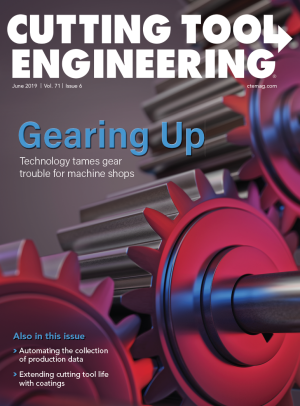Dear Doc: When cylindrical-plunge grinding ODs in hardened bearing steel with an aluminum-oxide wheel, I get thermal damage in the form of a white layer. To battle this burn, I’m going to redo our cooling system to get higher coolant velocities. What do you recommend?
The Doc Replies: My recommendation is this: Don’t bother. If you’re burning with bad cooling, you’ll burn with good cooling. For that OD grinding process, the coolant just doesn’t suck up enough heat to make a huge difference. You’re screwing up something else, and that’s why there’s burn.
There are two exceptions. First, if you’re burning because you’re loading the wheel, improved cooling—getting the coolant velocity close to the wheel velocity and aiming at the wheel-workpiece interface—will slow loading and perhaps delay the onset of burn. But unlike stainless steel and nickel-base alloys, bearing steel isn’t prone to severe loading. So I don’t think that bad cooling is the cause of the burn. The second exception is if you’re grinding with a 30° swivel and getting burn not on the OD but on the shoulder. Here, a dedicated, high-velocity nozzle to cool just the shoulder will reduce burn.
Using a wheel with too large of a grit size and dressing dull likely caused your OD burn. That’s the root cause of most of the burn in cylindrical-OD grinding that I see on shop floors—not bad cooling. Switch to a finer grit size, and dress sharper.
Dear Doc: The old-timer machinists at my shop say I should always dress and grind at the same wheel rpm. Are they right? If so, why?
The Doc Replies: Yes, you should try to grind and dress at the same rpm. Keep in mind that no wheel is perfectly balanced. So when a wheel is dressed, it pulls toward its heavy side. Imagine mounting a monster weight on just one side of a wheel. Now, imagine the centerline of the axis of rotation. When that wheel rotates during dressing, it will pull—and deflect—in the direction of the imbalance. Therefore, you’ll end up dressing deeper on its heavy side and less deep on its light side.
Now, your wheel is egg-shaped, and that is somewhat of a bad thing. But now when you grind, the wheel also will pull and deflect. And it will pull and deflect just the right amount to compensate for the “eggyness” of the wheel. But if you dress at a low rpm and grind at a higher one, your wheel will be only slightly eggy from the low rpm dressing. Yet the wheel needs to be very eggy during high-speed grinding.
So it’s best to dress and grind at the same rpm. Having said that, I’ve seen a lot of operations do just fine with a different rpm for dressing and grinding. That is because if the imbalance isn’t too bad, the spindle is very stiff or the tolerances aren’t too tight, you can survive with eggyness.
Dear Doc: I grind HSS and switched from pink alumina to Norton SG without much success. Why?
The Doc Replies: Because you’re grinding like a wimp. Pink alumina grit is friable, and Norton SG ceramic grit is tough. Be more aggressive by increasing the feed rate 25%, increasing the DOC 50% or decreasing the wheel speed 20%. Those are minimum recommendations. You probably should be even more aggressive. Tough grits need big forces to fracture them. Otherwise, they dull and burn.
Related Glossary Terms
- alloys
alloys
Substances having metallic properties and being composed of two or more chemical elements of which at least one is a metal.
- burning
burning
Rotary tool that removes hard or soft materials similar to a rotary file. A bur’s teeth, or flutes, have a negative rake.
- coolant
coolant
Fluid that reduces temperature buildup at the tool/workpiece interface during machining. Normally takes the form of a liquid such as soluble or chemical mixtures (semisynthetic, synthetic) but can be pressurized air or other gas. Because of water’s ability to absorb great quantities of heat, it is widely used as a coolant and vehicle for various cutting compounds, with the water-to-compound ratio varying with the machining task. See cutting fluid; semisynthetic cutting fluid; soluble-oil cutting fluid; synthetic cutting fluid.
- dressing
dressing
Removal of undesirable materials from “loaded” grinding wheels using a single- or multi-point diamond or other tool. The process also exposes unused, sharp abrasive points. See loading; truing.
- feed
feed
Rate of change of position of the tool as a whole, relative to the workpiece while cutting.
- grinding
grinding
Machining operation in which material is removed from the workpiece by a powered abrasive wheel, stone, belt, paste, sheet, compound, slurry, etc. Takes various forms: surface grinding (creates flat and/or squared surfaces); cylindrical grinding (for external cylindrical and tapered shapes, fillets, undercuts, etc.); centerless grinding; chamfering; thread and form grinding; tool and cutter grinding; offhand grinding; lapping and polishing (grinding with extremely fine grits to create ultrasmooth surfaces); honing; and disc grinding.
- grit size
grit size
Specified size of the abrasive particles in grinding wheels and other abrasive tools. Determines metal-removal capability and quality of finish.
- high-speed steels ( HSS)
high-speed steels ( HSS)
Available in two major types: tungsten high-speed steels (designated by letter T having tungsten as the principal alloying element) and molybdenum high-speed steels (designated by letter M having molybdenum as the principal alloying element). The type T high-speed steels containing cobalt have higher wear resistance and greater red (hot) hardness, withstanding cutting temperature up to 1,100º F (590º C). The type T steels are used to fabricate metalcutting tools (milling cutters, drills, reamers and taps), woodworking tools, various types of punches and dies, ball and roller bearings. The type M steels are used for cutting tools and various types of dies.
- outer diameter ( OD)
outer diameter ( OD)
Dimension that defines the exterior diameter of a cylindrical or round part. See ID, inner diameter.








